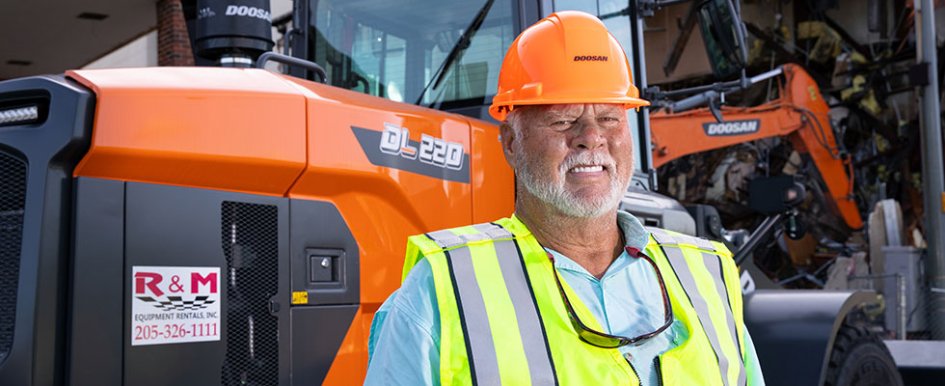
What was once a bustling and thriving area of Birmingham, Alabama, eventually became an economic blight, including the former Carraway Methodist Medical Center. That’s all changing now, thanks to a developer and a demolition contractor.
Established in 1908, the hospital was formerly a Level 1 trauma center. Financial setbacks eventually led to the closure of the facility in 2008. As the old Carraway hospital sat vacant, weeds crept up outside the perimeter. Graffiti appeared on the buildings. The old, tired medical center began to crumble from the inside.
Enter Corporate Realty and a plan for redevelopment. In 2020, the company worked with the city of Birmingham and the city council to get approval for rezoning the 50-acre site. In addition to the rezoning, the city council approved a $13 million incentive package for the property redevelopment.
According to local news reports in Birmingham, the developer plans to convert the former medical center site in north Birmingham into a multiuse development called The Star Uptown. Corporate Realty selected the development name in reference to the iconic blue star sitting atop the hospital. The new development will include office, retail, entertainment, hotel and multifamily residential space.
Salvaging Metal
Corporate Realty selected contractor Britt Demolition & Recycling to perform the demolition project. But before any demolition work began, superintendent Melissa Britt led a crew that performed a salvage operation. Owner Tommy Britt says there are always items left behind.
“Melissa goes in and separates the items into whatever we can sell,” Tommy says. “She salvages the copper, the lead, the electrical components — anything inside the building. She manages the process, gets it all out of the building, puts it on trucks and ships it out.”
Construction is second nature to Melissa. She’s been involved in the company for nearly 20 years, but recently took a leadership position as a superintendent.
“I have a crew size ranging from five up to 40,” Melissa says. “We go inside the building first and salvage nonferrous metal, anything that a magnet doesn’t stick to (copper, brass, aluminum, stainless steel), we pull it out, we process it and send it off. I came up with different ways of getting it out faster and more efficiently than before.
“I have it down to a science, almost,” she continues. “Every little thing that we do, like how we remove the plates off the wall. That way the process goes faster. Time is money, and we’ve got to hurry up and get out so the heavy equipment can come in and start taking down the building.”
Renovation Begins
In late July, Britt Demolition & Recycling prepared to begin tearing down most of the structures on the site. Led by Tommy, the employees moved their heavy construction equipment into place.
“This project is a million square feet of demolition and gutting of the old Carraway Methodist hospital for Corporate Realty,” Tommy says. “We’re tearing down about 650,000 square feet here: a complete teardown through the basement. We’re responsible for lowering the basements to five feet below grade. On the other 350,000 square feet, we’re gutting it out to the concrete structure.”
Tommy estimates that his company will work on the jobsite for nine months. While on-site, Tommy’s employees will recycle the concrete with a concrete grinder and the material will be used to refill the basements and the foundations.
An existing parking garage and at least one building on the property will be kept and renovated for future use.
Versatile Machines
One of the keys to Tommy’s demolition success is having the right equipment for each project. Not only do the machines have to be productive and versatile, but they need to be the correct size. Having a fleet of crawler excavators allows Tommy to best match the machines to the demolition project.
As Britt Demolition & Recycling started the demolition project, the company assigned three Doosan crawler excavators to begin the teardown. Early in the project, the company operated DX350LC-5, DX380LL-5 and DX490LC-5 excavators. Each machine was paired with a grapple attachment so the operator could grab parts of the building and tear it down.
In addition to the grapples, Britt Demolition & Recycling uses buckets, hammers, shears, concrete processors and magnets to separate and process the demolition debris.
“We have all the different attachments to go on almost each and every machine, so they’re all usable,” Tommy says.
Tommy estimates that at this jobsite, 85% of the waste — mostly concrete and metal — will be recycled. The brick will be repurposed,
and all the steel will be recycled.
Tommy purchases his construction equipment from R & M Equipment in Birmingham. “We never have any trouble with excavator booms breaking, no matter how much pressure we put on the machine,” Tommy says.
A Career in Demolition
More than 40 years ago, a tornado sparked a career interest for Tommy Britt. The tornado damaged a cigar plant, and Tommy was offered a job demolishing the buildings. Tommy admits he didn’t know anything about demolition, but he “did it and liked it.” From there, he landed work with the military doing demolition, grew his business and eventually got his contractor’s license in 1993. Since then, there’s been an abundance of civilian demolition work to keep Tommy and his employees busy. “It’s hard and dangerous work, and that’s why it’s not Britt and Sons,” Tommy says. “So, if you love equipment, you like tearing down stuff and you’ve got $2 million or $3 million, I guess you could start in this job now. But it’s not like it used to be. I don’t know how anybody could start a demolition business and turn it into what I’ve been blessed to be able to turn it into.”
